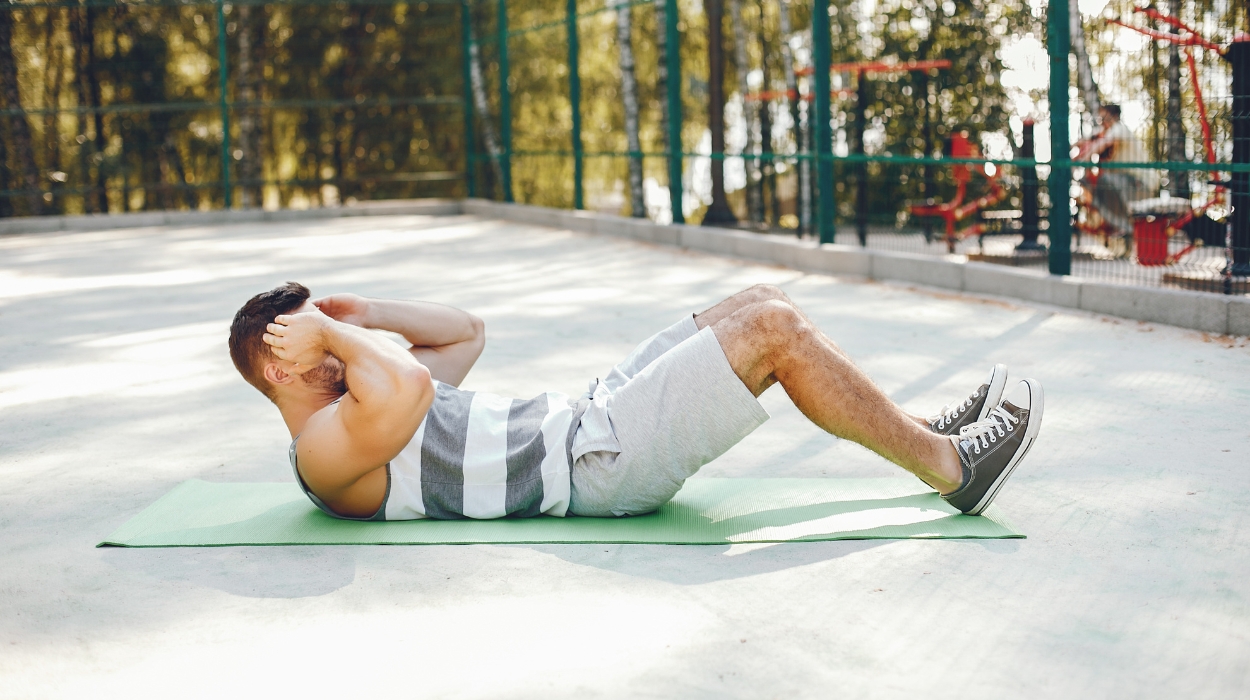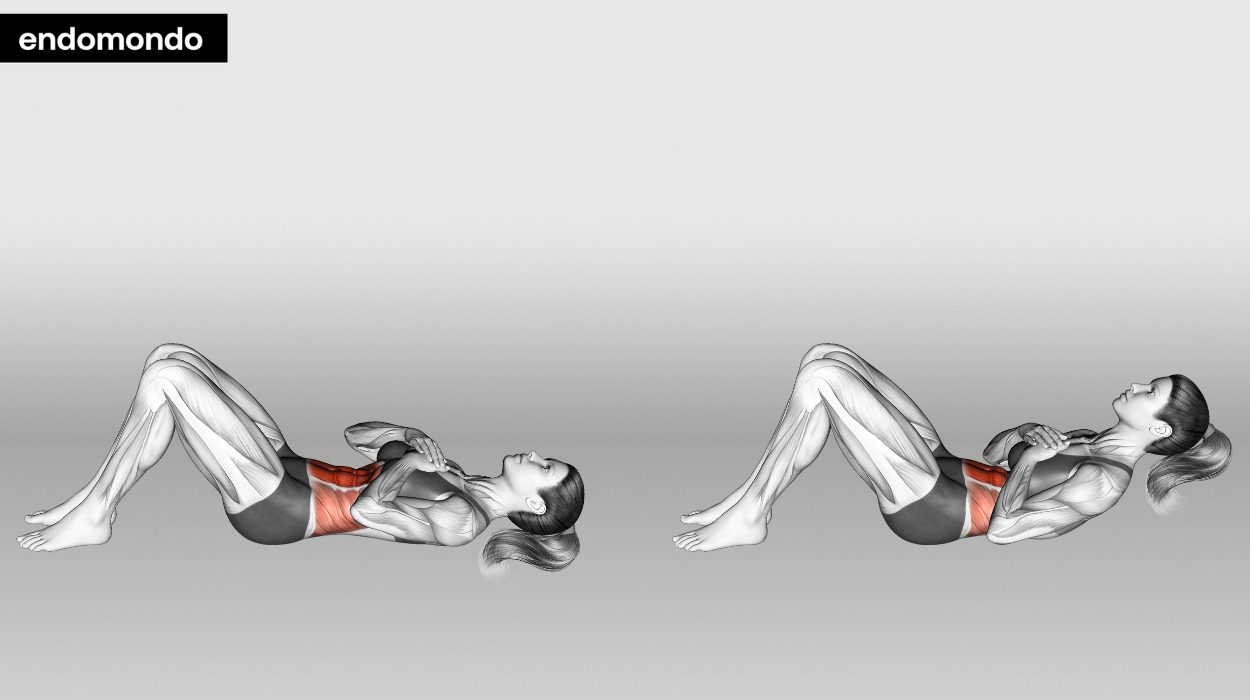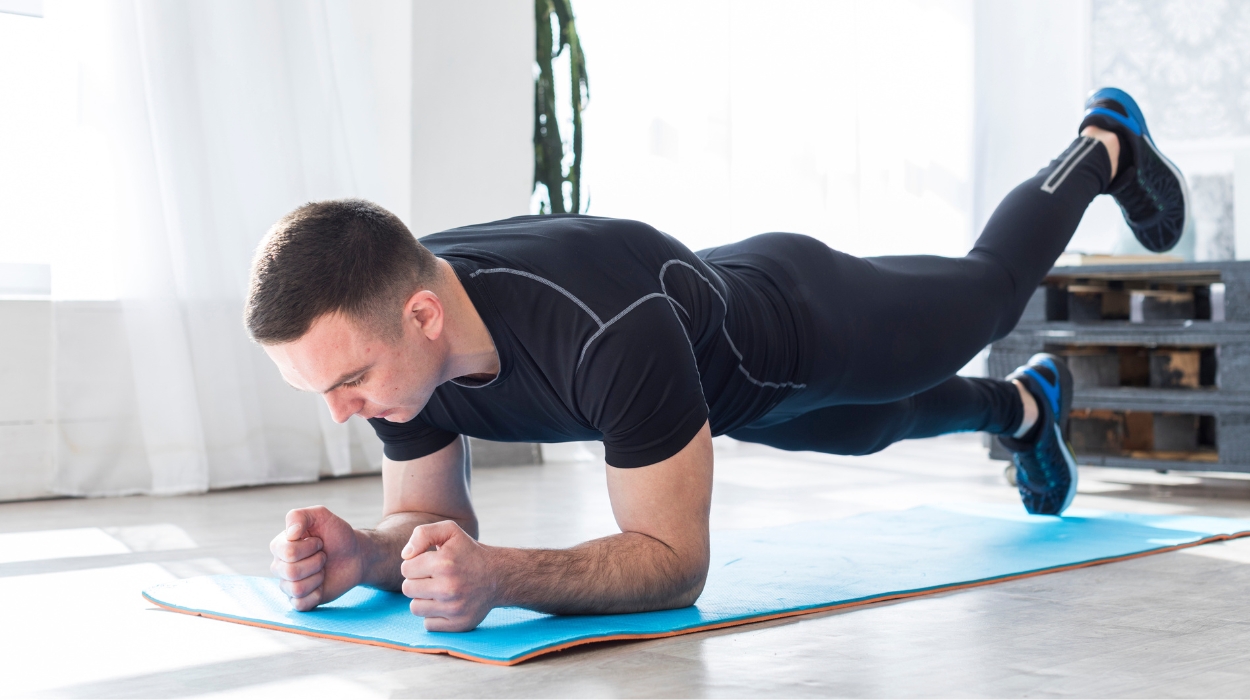
Building strong abs, tightening the core muscles, and flattening the belly are some of the main goals of those starting position their fitness journey.
Adding specific ab workouts into your daily exercise routine is key, and crunches are definitely a move you simply cannot miss. Find all related how to do crunches in this article.
How To Do Crunches Properly?
- Step 1: Supine Setup
- Step 2: Arm Cross
- Step 3: Breath Lift
- Step 4: Controlled Release
How To Do Crunches?

Knowing how to properly perform a crunch prevents potential injury and strain and it makes you get the most out of this incredible belly-flattening exercise. The technique is important, but so is preparation.
Before you start, make sure you’re on a comfortable surface that’s not too hard on your back. If you have pain in your lower back or a bruised coccyx, use double padding underneath. You can use a yoga mat or any other foam exercise mat.
To execute a crunch with proper form, these are the steps you have to take:
Step 1: Supine Setup
Start by lying down on your back with your knees bent. Place your feet flat on the floor and separate them hip-width apart.
Step 2: Arm Cross
Place your arms crisscrossed across your chest, and make sure your lower back is fully on the floor.
Step 3: Breath Lift
Take a deep inhale without lifting your lower back off the floor and exhale by lifting your chest up and activating your abs along the way. Prevent your head and neck from tensing up and relax your face.
Step 4: Controlled Release
Slowly come back down on your next inhale and repeat the crunch on your exhale.
Repeat this motion 10-20 times. Take a rest and repeat for three to five circuits.
Keeping your head and neck straight and relaxed is crucial as it will prevent any strains or injuries in this area. Let your movements be slow and controlled, and activate your core as much as you possibly can to avoid the crunch coming from your upper back muscles. Our bodies are known to tense up even without our knowledge, so be more aware of it as you keep going and repeating your moves.
What Are Crunches Exercises?
Crunches have been a popular exercise to flatten the belly and get six-pack abs for decades, with many new additions and modifications throughout the years. They are almost an inevitable part of every fitness program you’ll encounter, especially one that consists of body split days (upper body and lower body days).
As a bodyweight exercise that requires zero gym equipment, they are safe for almost everyone, from beginners to fitness fanatics. Unless you have a serious injury, you should definitely add them to your routine.
Crunches can complement any other exercise as they’re not very taxing on the body. This means you can definitely make the most out of them if you combine them with another ab-building move. And it can be really fun to play around with their modifications and advanced poses.
Crunch Modifications
If a basic crunch seems hard for you, you can always modify it by placing your hands behind your head and neck, supporting your upper body back as you lift up. You can also extend your arms in front of you and either clasp them together or keep them apart.
If you’re having issues with your lower back and they can’t easily fill out the space beneath you, place some extra padding. It’s important to keep your entire spine supported throughout the exercise.
If you’re having upper back issues and haven’t a neck-relaxed, you can place your hands underneath your back and perform reverse crunches in order to avoid any further straining.
Crunch Variations
On the other hand, if you want to take it a step further, there are a plethora of variations you can try out:
- Add a dumbbell or a sandbag to your chest to challenge your core muscles with added weight.
- Lift your legs off the ground to challenge your balance.
- Alternate your bent legs for bicycle crunches.
- Alternate your straight legs for scissor crunches.
- Side crunches target your oblique muscles and add an additional element of isolation.
- Reverse crunches strengthen the lower abs and really help flatten the belly in its most challenging area.
- Vertical crunches keep your legs extended as you perform the basic lifting motion.
- Diamond crunches keep your feet together and open your knees, placing them in a diamond shape on the floor.
- Bird dog crunches make you start on all fours, using the power of both, your leg and arm to activate your abs.
- Yoga crunches start from a downward dog, lifting one leg up and bringing your knee into your chest, crunching hard as you exhale.
How To Do Crunches For Beginners: Breathing Technique
Proper form breathing techniques are important in every good form of exercise and crunches are not excluded. Learning how to utilize deep, belly breaths ensures you take in as much oxygen as you can, helping fill out your cells with fresh blood. This enhances core strength and muscle toning.
Before doing your first crunch, place one palm on your chest and the other on your belly. Take a deep inhale and try to feel both of your hands lift, focusing on filling out your belly all the way. On your exhale, feel both of your hands lower, deflating the air out of your belly first and then your chest.
This is exactly what you want to be doing when performing how many crunches. Deep inhales to prepare and deep exhales as you lift up, feeling the burn in your abs.
Crunch Alternative Exercises

In addition to crunches, there are other great ab-building exercises and core exercises that can greatly complement this belly-flattening staple. These other popular core exercises include, but are not limited to:
- Plank – This plank-challenging pose still remains one of the best ab-building moves. It enhances your core strength, from front to back, and it helps build muscle on all sides.
- Side plank – Specifically targeting the obliques, side plank is an amazing ab-building exercise that helps activate the side body. Adding side crunches as a combo intensifies both movements and makes it even more challenging.
- Hollow Hold – Another amazing hold that activates your abdominal crunch muscles, this time your lower abs. Breathwork is so important in long holds, so think of deep breaths and take it slow.
- Ab Rollout – Using equipment such as an ab wheel can further intensify the ab exercises, helping you burn more fat and build stronger abs.
- Hanging L-Sit and leg raise – Using gravity to pull you down while trying to lift your legs up greatly isolates your abdominal muscles, making them work twice as hard since there is no ground support.
Key Information For Achieving A Flattened Belly
Nutrition To Help Flatten Belly
Another important factor to help flatten your belly and build stronger abs is your diet. Keeping it clean and focusing on adding more nutrient-dense foods while staying away from processed ingredients and added sugar will definitely help.
It’s important to keep your inflammation[1] on the down low in order to help your body get rid of excess fat in a more efficient way.
This means you should be eating more vegetables and fruit, healthy fats such as avocado, fatty fish, nuts, and lean meats, as well as drinking enough water on a daily basis to give your body the micronutrients it needs to thrive.
However, although cleaning up your diet will definitely help with lowering your overall inflammation, you also need to be in a caloric deficit[2] if you’re looking to lose weight. Where we store our body fat depends from person to person, and while some tend to store more in their lower bodies, others seem to gain weight more in the abdominal area.
Unfortunately, that means that those who store their fat in their lower bodies will see a flatter belly and more defined abs quicker than others. This is just genetics at play and if you fall in the latter category, you’ll need to really work on your nutrition to tap into those belly fat stores and burn them off.
Methods To Measure Your Caloric Intake
There are plenty of ways to gauge your caloric intake and expenditure,[3] so tracking (or counting) your calories will give you a good idea of how much you’re actually consuming and spending on a workout routine. The majority of people actually underestimate the number of calories they ingest daily. This is mostly due to the fact that they don’t know how many calories foods actually contain, but sometimes it’s also due to the fact that they don’t count as detailed.
For example, most people ignore liquid calories, that religious spoonful of sugar they put in their black coffee, the amount of oil they use to cook their food, or the amount of dressing they so generously pour over their healthy salads.
It’s easy to underestimate your caloric intake if you’ve been eating the same foods in the same way for years. This is where tracking your calories really helps you become more aware of your food choices and how to best modify them and optimize them to stay in a caloric deficit and burn your belly fat.
Stress Less For A Flatter Belly

Stress is a huge contributor to belly fat[4] and since our bodies can’t tell the difference between physical and mental stress, it’s important to become more mindful of it and work on keeping the level down. Introducing a more relaxing routine into your day helps your body wind down and focus on repair rather than staying alert.
Try adding more self-care, relaxing techniques such as meditation, breathwork,[5], journaling, music therapy, or even 20-min of bath time. Whatever works for you to bring your stress down, do it on a regular basis.
Sleep Is Your Best Friend
When we sleep, our body goes through a huge number of repair processes[6] that not only help us keep the weight down and build our muscles but also detoxify our system and clean out the dead cells, leaving more space for new ones to grow.
Creating a healthy, consistent sleeping routine is crucial to leading a healthy lifestyle and your overall health and well-being. Try getting to bed at the same times each night and waking up around the same hour, minimize the amount of time you spend in front of a blue screen before bedtime, avoid heavy meals at least two to three hours before going to sleep, and keep your bedroom relaxed and cozy.
Make sure your blinds are closed so your body experiences darkness while it sleeps, helping optimize its circadian rhythm,[7], and add on some additional tools such as relaxing essential oils, white noise, or even an air purifier to further enhance your sleep and minimize sleep disruptions.
When you wake up, go to your window and open the blinds. Help your body wake up naturally by allowing the light to enter your eyes and start your metabolism.
Conclusion
Crunches are an amazing core strengthening exercise to help you flatten your belly and build stronger ab muscles, but they’re not the only factor. Dialing up your diet, keeping your stress at bay, and creating a healthy sleeping routine is just as important.
Resources
- Sears, B. (2015). Anti-inflammatory Diets. Journal of The American College of Nutrition, [online] 34(sup1), pp.14–21. doi:https://doi.org/10.1080/07315724.2015.1080105.
- Strasser, B., Spreitzer, A. and Haber, P. (2007). Fat Loss Depends on Energy Deficit Only, Independently of the Method for Weight Loss. Annals of Nutrition and Metabolism, [online] 51(5), pp.428–432. doi:https://doi.org/10.1159/000111162.
- Howell, S. and Kones, R. (2017). ‘Calories in, calories out’ and macronutrient intake: the hope, hype, and science of calories. American Journal of Physiology-endocrinology and Metabolism, [online] 313(5), pp.E608–E612. doi:https://doi.org/10.1152/ajpendo.00156.2017.
- Donoho, C.J., Weigensberg, M.J., B. Adar Emken, Hsu, J.-W. and Spruijt-Metz, D. (2011). Stress and Abdominal Fat: Preliminary Evidence of Moderation by the Cortisol Awakening Response in Hispanic Peripubertal Girls. Obesity, [online] 19(5), pp.946–952. doi:https://doi.org/10.1038/oby.2010.287.
- Ma, X., Zi Qi Yue, Zhu Qing Gong, Zhang, H., Nai Yue Duan, Yu Tong Shi, Gao Xia Wei and You Fa Li (2017). The Effect of Diaphragmatic Breathing on Attention, Negative Affect and Stress in Healthy Adults. Frontiers in Psychology, [online] 8. doi:https://doi.org/10.3389/fpsyg.2017.00874.
- Vyazovskiy, V.V. (2015). Sleep, recovery, and metaregulation: explaining the benefits of sleep. Nature and Science of Sleep, [online] pp.171–171. doi:https://doi.org/10.2147/nss.s54036.
- Farhud, D. and Aryan, Z. (2018). Circadian Rhythm, Lifestyle and Health: A Narrative Review. Iranian journal of public health, [online] 47(8), pp.1068–1076. Available at: https://www.ncbi.nlm.nih.gov/pmc/articles/PMC6123576/.




